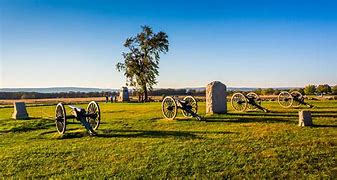Perhaps no other battle in the history of the U.S. has been discussed and analyzed more than the battle of Gettysburg. Over the years of visiting this historic place, I have come to see it in a brand new light. Maybe it has to do with the current political strife that envelopes our nation.
Considered the most important engagement of the American Civil War, the battle of Gettysburg was fought from July 1 to July 3, 1863. While many Americans may be aware of the significance of this pivotal battle, which claimed thousands of casualties, few likely understand how close the South came to winning this battle, after which they surely would have marched on to the lightly defended Union capital, located just sixty miles away.
Of the above-mentioned casualties on both sides, there were 7,058 fatalities, 33,264 wounded and 10,790 missing from the fierce fighting.
After a great victory over Union forces at Chancellorsville just two months before, General Robert E. Lee marched his Army of Northern Virginia into Pennsylvania in late June 1863. On July 1, the advancing Confederates clashed with the Union Army of the Potomac, commanded by General George G. Meade, at Gettysburg. The next day saw even heavier fighting, as the Confederates attacked the Federals on both their left and right flanks.
On July 3, Lee ordered an attack on the enemy’s center at Cemetery Ridge, an assault known as “Pickett’s Charge.” The charge managed to pierce the Union lines, but eventually failed at the cost of thousands of Confederate casualties. Lee was forced to withdraw his battered army toward Virginia on July 4.
The Union had won a pivotal battle at a great cost, stopping Lee’s invasion of the North. It inspired Lincoln’s “Gettysburg Address,” which became one of the most famous speeches of all time, at only 271 words.
The aftermath of the battle devastated this once quiet town, whose residents were forced to hide while the battle raged around them. Confederate soldiers displaced homeowners as sharpshooters perched themselves in the attics of homes to fire at the approaching Union army.
After the battle, at various field hospitals, amputated limbs lay in heaps as bodies were collected and buried where they fell. Elizabeth Thorn, wife of the manager of the town’s largest cemetery, reportedly dug over 100 graves herself, despite being pregnant.
The Cashtown Inn, where I stayed last October, was used as a field hospital where hundreds of amputations were performed.
Lydia Smith, a black woman, used what little money she had to hire a wagon and team, which she used to gather donated goods throughout the area, which she delivered to both Union and Confederate wounded.
Apart from the human carnage, some 5,000 horses and mules died in the battle. They, too, had to be collected and burned in great pyres, leaving a stench that hung over the area for weeks. It would take months for life to return to normal in this small town, where bullet holes in the sides of buildings remain to this day.
Despite occurring at the midpoint of the war, the battle of Gettysburg set a new standard of suffering and death.
There are a myriad number of ways to explore Gettysburg, located just 265 miles from Smithtown. Although the conventional wisdom is to visit Gettysburg National Park, it might be better to first familiarize yourself with the battle itself before visiting. By doing so, you will be somewhat oriented when you visit the park, sign up for a bus tour, or even a private tour by a park ranger. For more information see visitgettysburgpa.com.
On my last visit to Gettysburg in October, I did a house tour which chronicled one of the families who were living in Gettysburg during the battle. After dark, I did a walking ghost tour, and the next morning I visited the museum at Seminary Ridge. This particular museum uses real-life wax figures to depict scenes from Gettysburg, including care of the wounded. All these attractions were amazing and enhanced my knowledge and understanding of this place.
Also on this particular visit, which happened to fall on a gorgeous autumn day with crisp, cool air, I stood on the battlefield where General Pickett was repulsed by the Union line on the third day of the battle. Looking out over the field, I pondered all that has transpired since the Civil War; the Jim Crow Era, segregation, the Civil Rights movement, more wars, political assassinations, and of course the aforementioned ongoing political strife and division. I think about how far we’ve come and how, just like the toughest moments our nation has endured, we will overcome our current strife and division. Whatever sites you choose to visit at Gettysburg, be it Gettysburg National Park, the various museums and antiquity shops, or the ghost tours, take a moment to visit the battlefield and reflect on the significance of what happened here, what has occurred since, and what is yet to come.







